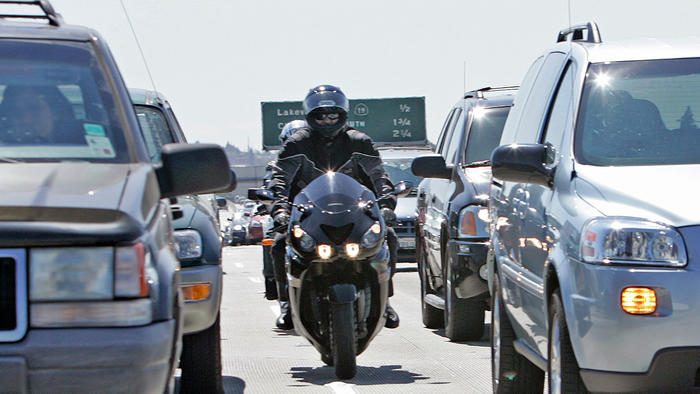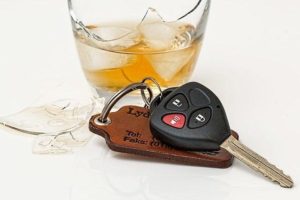Lane splitting is a hot topic for motorcyclists nationwide. Much of the debate regards the safety of lane splitting, especially in areas of heavy traffic and congestion. The Hurt Report, one of the most comprehensive studies on motorcycle safety, notes that most motorcycle collisions occur in areas of moderate to heavy traffic. Allowing bikers to move through areas of congestion and traffic reduces their exposure to accelerating and decelerating vehicles. This can reduce the likelihood of rear-end collisions.
Throughout the world, lane splitting is common. Filtering through to the front of traffic is normal practice for bikers in Asia and Europe, and motorists expect this to occur. Scooters and motorcycle riders alike maneuver their bikes through high traffic areas. This helps cut down on overall road traffic and protects those most vulnerable to read-end collisions.
For a free legal consultation,
call 1-800-668-6729
In most areas of the United States, lane splitting is not allowed. One major exception is California which passed a law in 2016 authorizing the state Highway Patrol to create a set of guidelines to legalize lane splitting. Several other states are considering similar action. Most of these changes stem from recent studies which have shown that lane splitting can reduce the number of crashes that occur. One study by the University of California at Berkeley (2015) concluded that bikers who split lanes in heavy traffic situations are less likely to be involved in crashes and less likely to sustain head, torso, or fatalities if they are involved in a crash.
The findings of the UCLA Berkeley study and others conducted around the world have led the National Agenda for Motorcycle Safety (NAMS) to provide their support of further consideration and study into the impact of lane splitting. In their report, they find:
“There is evidence (Hurt, 1981) that traveling between lanes of stopped or slow-moving cars (i.e., lane splitting) on multiple-lane roads (such as interstate highways) slightly reduces crash frequency compared with staying within the lane and moving with other traffic.”
This opinion is similar to that issued by the Motorcycle Industry Council, which states that they support laws allowing lane splitting with reasonable restrictions.
Those against motorcycle lane splitting argue that it adds additional risk to motorists on the road, as they might encounter bikers maneuvering in and out of their lane in heavy traffic conditions. They condemn the risky behaviors of irresponsible bikers who create unsafe situations when they speed through traffic and weave in and out between moving vehicles.
Click to contact our personal injury lawyers today
Obviously, there is a big difference between lane splitting in a safe, cautious manner and reckless maneuvering. Safe lane splitting is a way to avoid potential crashes and keep bikers free from harm. Irresponsible, reckless riding creates unsafe conditions for all on the road and should not be tolerated.
If you live in an area where lane splitting is allowed, here are some tips to keep safe.
Complete a Free Case Evaluation form now
1. Is it safe to split lanes where you are? Are the lanes wide enough to allow you to move safely through traffic without endangering others on the road? If the lanes are too narrow, do not split. Also, check out the drivers around you. Are they attempting to move to different lanes (are their turn signals on)? Are they distracted by texting or other activities in their car?
2. Only split lanes when riding at a safe speed. Lane splitting safe at speeds of less than 30 miles per hour. You need ample time to react and brake, so speeds higher than this represent too great a risk.
3. Avoid exits and intersections. Drivers are more likely to change lanes rapidly near exits and intersections, posing extra risk for the lane splitting biker. Don’t split in these conditions.
4. Be aware of the reactions to others! Cover your brakes and be ready to stop at a moment’s notice. Lane splitting requires you to be fully focused on the road around you. Look two to three car lengths ahead and remain alert.
5. Be friendly to others on the road. If someone moves their car to prevent you from proceeding, don’t give him the finger. Simply wait patiently for traffic to proceed. Remember that not everyone knows about or supports lane splitting. In my experience, I have rarely encountered this behavior as I ride responsibly.
6. It’s best to avoid motorcycle lane splitting if you are riding with your buddies. Several bikers maneuvering through traffic at once can present unsafe conditions. Motorists may ease over to allow room for you to pass, and this can mean cutting off your fellow biker.
Be sure to follow the laws of your jurisdiction when choosing whether or not to lane split. If you do, be sure to exercise extra caution. At Kass & Moses, we know you want to arrive at your destination quickly and safely. But we have seen the results of unsafe riding, and urge you to remain alert and ride defensively. If you are involved in a crash, keep our number handy and contact us for important steps you can take to protect your rights. You can reach us anytime at 1-800-MOTORCYCLE. At Kass & Moses, our experienced motorcycle crash lawyers put your well-being first! We are all bikers, so we know a thing or two about the community, and we will do everything in our power to help you get the settlement you deserve in your case.
Call or text 1-800-668-6729 or complete a Free Case Evaluation form


